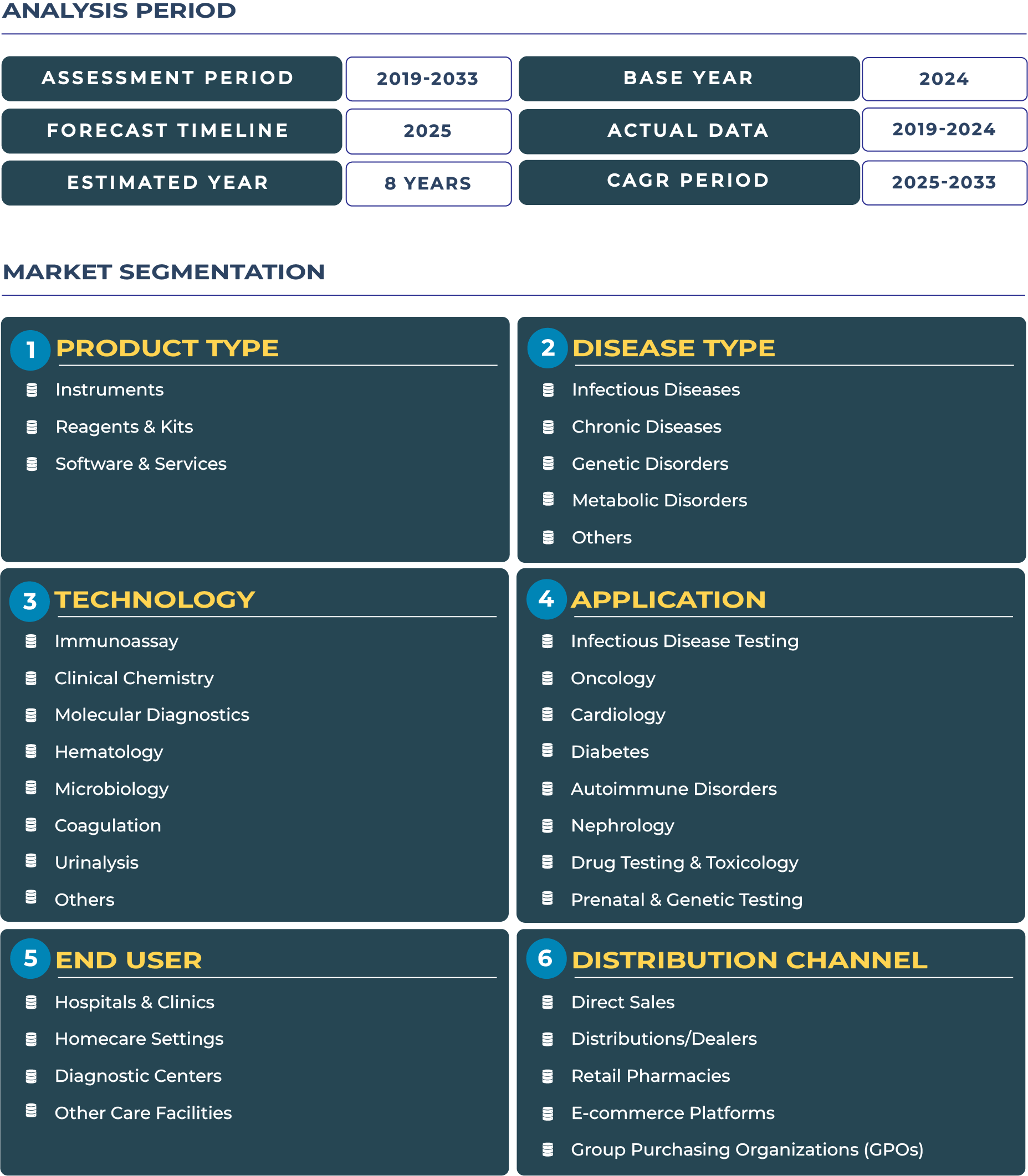NHS Procurement Power and Innovation Balance: How the UK’s Healthcare System Shapes the In-vitro Diagnostic Market
The United Kingdom’s healthcare ecosystem is heavily defined by the operational and financial influence of the National Health Service (NHS). As the largest publicly funded healthcare system in Europe, the NHS sets the tone for accessibility, procurement standards, and pricing for medical technologies, including in-vitro diagnostic (IVD) devices and services. The NHS’s centralized procurement model ensures equitable distribution and cost control but also slows the pace of innovation adoption in diagnostics. This delicate balance between affordability and advancement is reshaping the UK’s IVD landscape, where suppliers must align innovation with value-based outcomes to gain NHS acceptance.
In 2025, the UK In-vitro Diagnostic Market is estimated at USD 4.67 billion and is projected to reach USD 6.40 billion by 2033
UK In-vitro Diagnostic Market Outlook: NHS-Centric Healthcare Challenges and Their Influence on Diagnostic Innovation
The NHS acts as both a catalyst and gatekeeper for the UK in-vitro diagnostic industry. While it guarantees nationwide healthcare coverage, the procurement framework prioritizes cost-effectiveness over rapid adoption of emerging diagnostic technologies. This has created a system that rewards long-term value rather than short-term innovation. Nonetheless, recent NHS modernization efforts, such as diagnostic network optimization and integrated care systems (ICS), are accelerating decentralization of diagnostic testing and enabling local authorities to adopt digital diagnostic platforms for faster disease detection and population health monitoring.
Major cities such as London, Manchester, and Birmingham have witnessed increased investment in advanced diagnostic centers offering automated analyzers and software-driven pathology workflows. Additionally, NHS England’s focus on tackling the testing backlog post-pandemic has created new opportunities for instrument manufacturers and reagent suppliers to provide scalable solutions. The government’s push toward localized genomic testing and precision medicine is also positioning the UK as a regional hub for specialized diagnostics, ensuring that both private laboratories and NHS partners benefit from sustained infrastructure growth.
Drivers & Restraints: Balancing Innovation with Cost Efficiency in a Publicly Funded Healthcare System
NHS Backlog, High Testing Rates, and Evidence-Based Clinical Guidelines Propel Growth
Post-pandemic recovery initiatives have prioritized diagnostics as a foundation for effective healthcare delivery. NHS England’s elective recovery plan, introduced in 2024, includes significant funding for expanding testing capacity and clearing the diagnostic backlog. The UK’s high per-capita testing rates for chronic and infectious diseases have led to a surge in demand for molecular diagnostics, reagents, and software-integrated laboratory systems. Additionally, clinical guidelines from NICE (National Institute for Health and Care Excellence) strongly influence procurement and implementation of diagnostic technologies, ensuring that the market grows under a framework of clinical validation and patient outcome optimization.
Private healthcare institutions are also contributing to this demand by integrating advanced IVD systems to complement NHS services. This dual structure of public-private collaboration helps sustain consistent demand for reagents, kits, and instrument maintenance services, especially in high-volume testing categories like oncology, infectious diseases, and cardiovascular screening.
Procurement Centralization and Budget Constraints Limit Market Agility
Despite positive momentum, the UK in-vitro diagnostic sector faces structural limitations. The centralization of NHS procurement often results in long approval cycles for new diagnostic instruments, particularly those requiring novel digital integration or cloud connectivity. Vendors must undergo rigorous cost-effectiveness assessments before gaining NHS endorsement, delaying commercialization timelines. Moreover, public budget constraints and economic uncertainty stemming from inflationary pressures limit hospital spending on premium diagnostic instruments. The ongoing debate between efficiency and innovation continues to shape market entry strategies, compelling suppliers to design cost-optimized systems and total-cost-of-ownership (TCO)-based service models to align with NHS requirements.
Trends & Opportunities: Navigating NHS Modernization and Emerging Regional Pathways
Elective Recovery Programs and Value-Based Tendering Redefine Procurement Dynamics
Recent NHS initiatives emphasize backlog clearance and improved patient outcomes, transforming the diagnostic procurement environment. The introduction of regional Integrated Care Systems (ICS) has decentralized certain purchasing decisions, allowing faster adoption of localized diagnostic solutions. Hospitals in regions such as Greater Manchester and West Midlands are now leveraging managed equipment services to modernize diagnostic laboratories. Additionally, value-based tendering, where outcomes and efficiency outweigh upfront costs, is becoming a key determinant in NHS purchasing. This evolution is prompting diagnostic companies to focus on evidence-based results and outcome-linked pricing models.
Partnerships and Managed Service Models Offer Strategic Growth Opportunities
The UK in-vitro diagnostic market is witnessing a steady rise in managed service partnerships with the NHS, where suppliers provide not just instruments but end-to-end laboratory services. Companies are piloting outcome-led programs tied to backlog clearance and reporting accuracy. These partnerships reduce the procurement friction while aligning vendor performance metrics with NHS efficiency goals. Moreover, collaboration between industry and public laboratories is enhancing digital data exchange and clinical decision support through AI-assisted pathology. The long-term opportunity lies in combining affordability, innovation, and outcome-based service delivery to reinforce NHS sustainability while advancing diagnostic excellence.
Competitive Landscape: Strategic Alliances and Value-Driven Innovation Dominate the Market
The competitive environment of the UK in-vitro diagnostic landscape is defined by the dominance of both global players and specialized domestic suppliers. Companies such as Roche Diagnostics, Abbott, Siemens Healthineers, and Randox Laboratories maintain strong ties with NHS trusts and regional ICS networks. In 2024, several managed service pilot programs were launched in collaboration with NHS pathology networks, focusing on reagent supply optimization and digital reporting solutions. These initiatives represent a new phase of market engagement centered on data-driven operations and continuous performance monitoring.
Emerging companies are also contributing to innovation through localized reagent manufacturing and modular software solutions designed for NHS labs. By leveraging public-private partnerships, diagnostic firms are successfully addressing procurement challenges, extending service contracts, and aligning pricing structures with NHS cost frameworks. This competitive balance between global expertise and local adaptability continues to strengthen the UK’s diagnostic ecosystem, reinforcing its global leadership in evidence-based medicine and laboratory efficiency.







